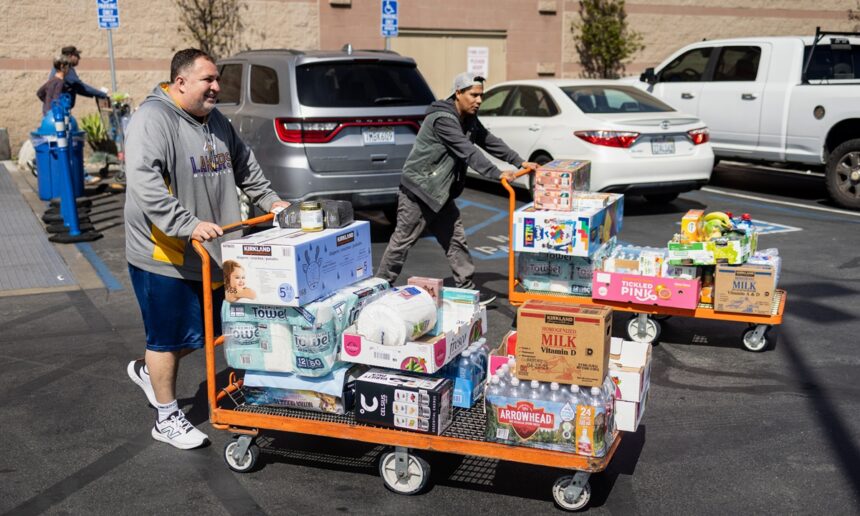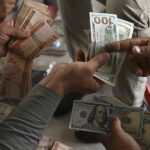By Yang Shasha and Ma Tong
On April 6, Maggie Xu, a Maryland resident, took her college-bound daughter to their local Best Buy – a major North American retailer – only to find chaos caused by confusion over the “reciprocal tariffs” recently imposed by the US government. “The store was packed by people, way busier than usual,” Xu told the Global Times.
From high-value goods to basic household products, Chinese-made goods have become hoarding targets among US consumers. “The last time we saw this kind of panic buying was during the COVID-19 pandemic,” Xu recalled. “Back then, people weren’t specifically snapping up Chinese products, but this time everyone’s scrambling for affordable daily necessities that are made in China,” she said.
Xu added that Indian-made towels and Vietnamese-made shoes were also in high demand, describing the scene as “absolute madness — complete disorder that’s got everyone on edge.”
For “Made in China” products like phone sets and laptops, people’s panic buying is especially pronounced, for fears that prices of products such as iPhones and Macbook laptops could surge in the US, due to US tech companies’ heavy reliance on imports from China.
Even as the US administration has reportedly exempted smartphones, computers, and some other electronics from steep “reciprocal tariffs,” concerns remain. Fears of skyrocketing prices and runaway inflation are growing among American consumers, especially amid warnings from US tech companies that gadget prices could continue to rise.
John Davis, a media professional in California, highlighted the trade war’s toll on ordinary Americans. “Major media outlets here are all reporting panic buying at the supermarkets, while car dealerships are seeing a run on imported vehicles,” Davis told the Global Times.
“I just hope the US current administration won’t keep going further down this wrong path,” Davis said.
Tariff panic spreads
After the US announced the full implementation of the “reciprocal tariffs” earlier this month, purchases of goods including canned and jarred vegetables, instant coffee, ketchup and beer jumped, CBS news reported, citing data from Consumer Edge, a consumer analytics platform.
Although the US government has announced a 90-day pause on “reciprocal tariffs” on most countries and regions, that hasn’t stopped American consumers from stocking up food and other necessities.
Tariffs have inevitably fueled widespread public dissatisfaction because protectionism ultimately backfires on consumers by raising prices and increasing living costs, Clara Bai, a software engineer working in a high-tech corporation in Silicon Valley, told the Global Times.
Bai said that people around her have noticed a recent increase in food prices of about 20-30 percent. “Eggs, in particular, have gone up significantly. A carton of eggs used to cost $5 or $6, but now it’s $8 or $9,” Bai said, adding that the steep rise in clothing prices has led her to cut back on purchases.
Bai noted that although spending on necessities makes up a small portion of her family’s budget, prices have been rising steadily. “For my family, a Costco run used to cost $200 to $300. Now it has doubled,” she said.
The impact is far more severe for economically vulnerable groups, Bai said. “Those people can’t even afford rent for a single-room apartment in the Bay Area, known for high housing prices, and now rising grocery prices are making lives even harder.”
The US is facing a dual impact: A short-term demand shock and a longer-term inflation expectation from both businesses and consumers, two factors that are likely to further drive prices upward, said Hu Qimu, a deputy secretary-general of the digital-real economies integration Forum 50.
The Budget Lab at Yale estimates that the 2025 tariffs will raise overall price levels by 2.3 percent in the short run, the equivalent of an average per household loss of $3,800 per American household in 2024 dollars.
Hu cautioned that the US market has yet to fully absorb existing inventory, which explains why prices haven’t surged dramatically. However, once stockpiles of certain goods are depleted, prices could surge rapidly – potentially sparking further public outrage.
These ripple effects will impact US businesses too, especially small and medium-sized enterprises, as rising production, logistics and labor costs compress profit margins, creating a vicious cycle across supply chains, Hu added.
Rising risk of stagflation
Lisa Foster, owner of a small Ohio-based dress company that relies heavily on Chinese suppliers, said she is in crisis mode. “The tariffs have suddenly surged from some 20 to 104 percent, that is completely unaffordable for me,” she told the Global Times.
“My order volumes from Chinese manufacturers are small compared to those big brands, and our per-unit costs were already high, so there’s very little room for us to raise prices,” Foster noted. “We’re considering cutting back our product line to focus on the best-sellers, but it risks losing what makes us unique,” Foster said.
On the supply side, Liu Kening’s flower export business illustrates how tariffs disrupt the entire value chain.
Liu, chairman of Yunnan Yeshun Technology Co, a flower export firm based in Kunming, Southwest China’s Yunnan Province, said that tariffs have not significantly changed his production costs in China, including raw material procurement, processing, and export.
But further down the supply chain in the US, businesses face a difficult choice – absorb unsustainable cost increases themselves or pass tariff expenses to consumers, which means ordinary Americans will finally pay the price, Liu told the Global Times.
Liu emphasized that the US tariff policy risks eroding international business confidence in the US market, potentially accelerating the departure of foreign firms seeking more stable alternatives. “Our Japanese clients are shifting orders from their California suppliers to us. We have already secured a 400 million yuan ($27.2 million) contract this year,” he added.
Hu warned that escalating US tariff levies would trigger a dangerous economic spiral, significantly driving up living and production costs. “It risks plunging the US into stagflation,” Hu warned.













